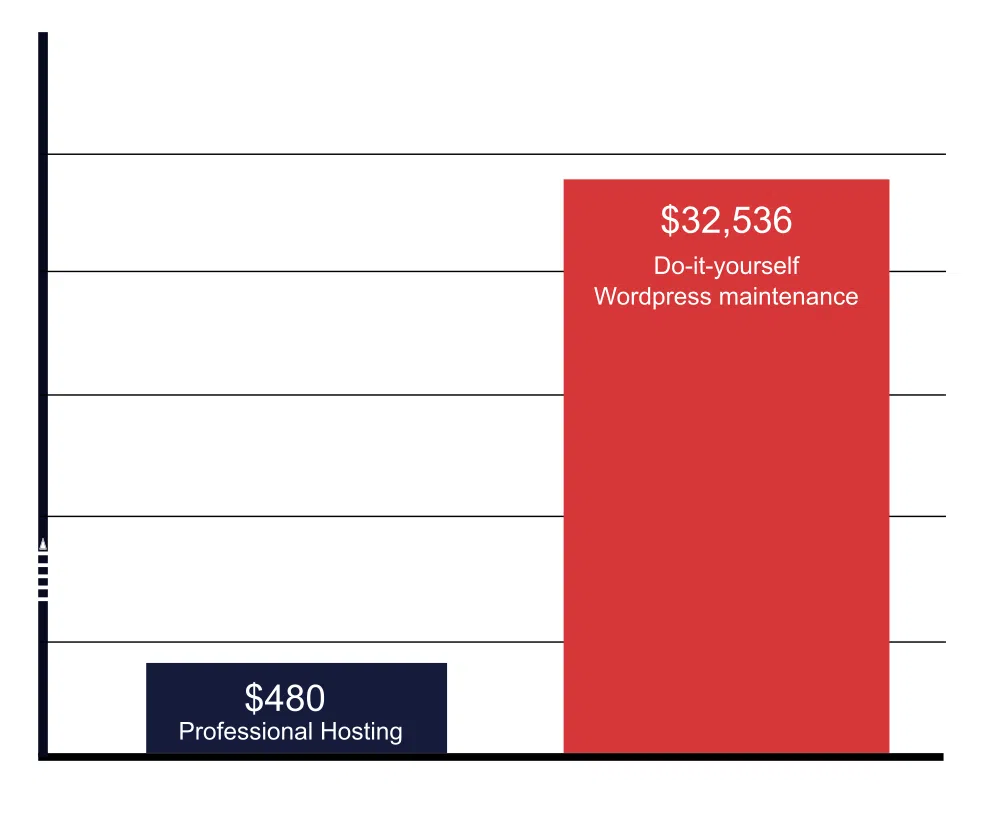Sarah thought she was being smart about money.
As a marketing consultant launching her own practice, every dollar mattered. When she saw managed WordPress hosting plans starting at $40 per month, she balked. “I can figure this out myself,” she told herself, opting for a $5/month shared hosting plan instead.
Twelve months later, Sarah had spent $2,847 and lost an estimated $15,000 in business opportunities. Here’s the month-by-month breakdown of what “saving money” on WordPress hosting actually cost her.
Month 1-3: The Learning Curve Tax
Sarah’s Time Investment: 47 hours
Direct Costs: $347
Hidden Costs: Delayed business launch
What Happened: Sarah quickly discovered that cheap hosting came with zero hand-holding. Her first challenge: getting SSL certificates configured properly. What should have taken minutes stretched into a weekend project involving support tickets, forum searches, and YouTube tutorials.
The Breakdown:
- 15 hours wrestling with DNS settings and SSL configuration
- 12 hours learning caching plugins after her homepage took 8 seconds to load
- 8 hours troubleshooting plugin conflicts that broke her contact forms
- 12 hours dealing with email deliverability issues
- $89 for premium plugins to fix performance issues
- $199 for a developer consultation when she accidentally broke her site
- $59 for backup plugin after realizing her host’s backups were unreliable
The Reality Check: Sarah’s hourly rate for client work was $125. Those 47 hours represented $5,875 in lost billable time. Her “money-saving” decision had already cost her business over $6,000 in opportunity costs.
Month 4-6: The First Crisis
Sarah’s Time Investment: 31 hours
Direct Costs: $580
Hidden Costs: Client trust and referral opportunities
What Happened: Sarah’s site went down during a product launch. Her shared hosting provider took 18 hours to respond to her support ticket, citing “resource limits exceeded.” During the outage, she lost three potential high-value clients who couldn’t access her case studies.
The Crisis Response:
- 18 hours of downtime during a critical business period
- 8 hours on support calls and troubleshooting
- 5 hours researching and migrating to a new hosting provider
- $299 for emergency migration services
- $89 for monitoring tools to prevent future surprises
- $192 for a CDN service to handle traffic spikes
Lost Opportunities: Three potential clients worth an estimated $4,500 each couldn’t access her portfolio during the outage. Two of them hired competitors instead.
Month 7-9: The Security Wake-Up Call
Sarah’s Time Investment: 28 hours
Direct Costs: $445
Hidden Costs: Brand reputation and client confidence
What Happened: Sarah’s site was compromised with malware. Google flagged it as “potentially harmful,” and her hosting provider suspended the account. She discovered her “daily backups” hadn’t worked in two months.
The Recovery Process:
- 12 hours rebuilding the site from a three-month-old backup
- 6 hours recreating lost content and client testimonials
- 4 hours implementing security measures she should have had from day one
- 6 hours dealing with Google’s review process to remove security warnings
- $199 for malware removal services
- $156 for premium security plugins and services
- $90 for SSL certificate renewal and security audit
Business Impact: Two existing clients questioned working with someone who “couldn’t keep their own website secure.” One client paused their project until security issues were resolved.
Month 10-12: The Performance Plateau
Sarah’s Time Investment: 21 hours
Direct Costs: $289
Hidden Costs: SEO rankings and conversion optimization
What Happened: Sarah’s site performance had slowly degraded. Page load times averaged 6-8 seconds, and Google Search Console showed crawl errors and indexing issues. Her organic traffic had dropped 40% from its peak.
The Optimization Attempts:
- 8 hours learning about Core Web Vitals and technical SEO
- 7 hours trying different caching configurations that kept breaking functionality
- 6 hours optimizing images and troubleshooting database issues
- $129 for additional performance plugins and tools
- $89 for technical SEO audit from freelancer
- $71 for image optimization services
Missed Opportunities: Slow site speed meant 35% of visitors left before the page finished loading. Google research shows that 53% of mobile users abandon sites that take longer than 3 seconds to load. Conservative estimates suggest this cost her 8-12 potential clients over the quarter.

The 12-Month Reality Check
Total Time Invested: 127 hours
Total Direct Costs: $1,661
Total Opportunity Costs: $15,875 (127 hours × $125/hour)
Total Business Impact: $2,847 in hard costs + $15,000+ in lost revenue
What Sarah Actually Paid for DIY WordPress:
- Upfront costs: $1,661 in hosting, plugins, and emergency fixes
- Time costs: $15,875 in billable hours spent on technical issues
- Opportunity costs: $15,000+ in lost clients and projects
- Stress costs: Immeasurable late nights, weekend “emergencies,” and client relationship strain
Grand Total: $32,536 for what she thought would save her money.

The Alternative: What Professional Hosting Would Have Cost
Managed WordPress Hosting: $40/month × 12 months = $480
Additional Services Included:
- Automatic security updates and malware protection
- Regular backups with restoration capabilities
- 24/7 expert support with priority response times
- Server-level performance optimization
- SSL certificates and security features included
- Professional staging environments for safe testing
Total Professional Cost: $480
Sarah’s DIY Cost: $32,536
The Difference: $32,056
The Hidden Costs Nobody Talks About
Beyond the obvious time and money costs, Sarah’s DIY approach created several business-critical problems:
Client Confidence Issues: Professional clients expect professional infrastructure. Website downtime and security issues raised questions about her overall competency.
Opportunity Cost Compound Effect: Every hour spent troubleshooting was an hour not spent on business development, client work, or strategic planning.
Stress and Burnout: Constant technical fires created anxiety around her online presence. She found herself checking her website obsessively and losing sleep over potential issues.
Competitive Disadvantage: While Sarah fought technical battles, her competitors focused on client acquisition and service delivery.
The Business Lesson
Sarah’s story isn’t unique. We see this pattern repeatedly: smart, capable business owners who excel in their field struggle with WordPress technical management because it’s not their core expertise.
The False Economy: Choosing DIY hosting to “save money” often costs 10-50x more than professional management when you factor in time, opportunity costs, and business impact.
The Real Question: Is learning WordPress server management the best use of your time and expertise? For most business owners, the answer is definitively no.

What Sarah Learned
After her 12-month DIY experiment, Sarah made the switch to managed WordPress hosting. Here’s what changed:
- No more 3 AM technical emergencies
- Zero hours per month on server management
- Improved site performance leading to better conversion rates
- Professional-grade security that client audits consistently approve
- Reliable support that treats her business as a priority
Sarah’s Conclusion: “I thought I was saving money, but I was actually losing it. The peace of mind alone is worth the investment, but the time I got back to focus on my actual business has been invaluable.”
The Real Cost of DIY: Your Decision
Every business owner faces this choice: invest time learning technical skills outside your expertise, or partner with specialists who make it their business to excel in these areas.
The question isn’t whether you’re capable of managing WordPress hosting yourself. The question is whether it’s the most profitable use of your time and energy.
If you’re spending more than a few hours per month on website technical issues, you’re probably paying far more for DIY hosting than you realize. Sometimes the most expensive solution is the one that appears cheapest upfront.
Ready to calculate what DIY WordPress is really costing your business? Let’s audit your current setup and show you exactly where your time and money are going. The results might surprise you.
